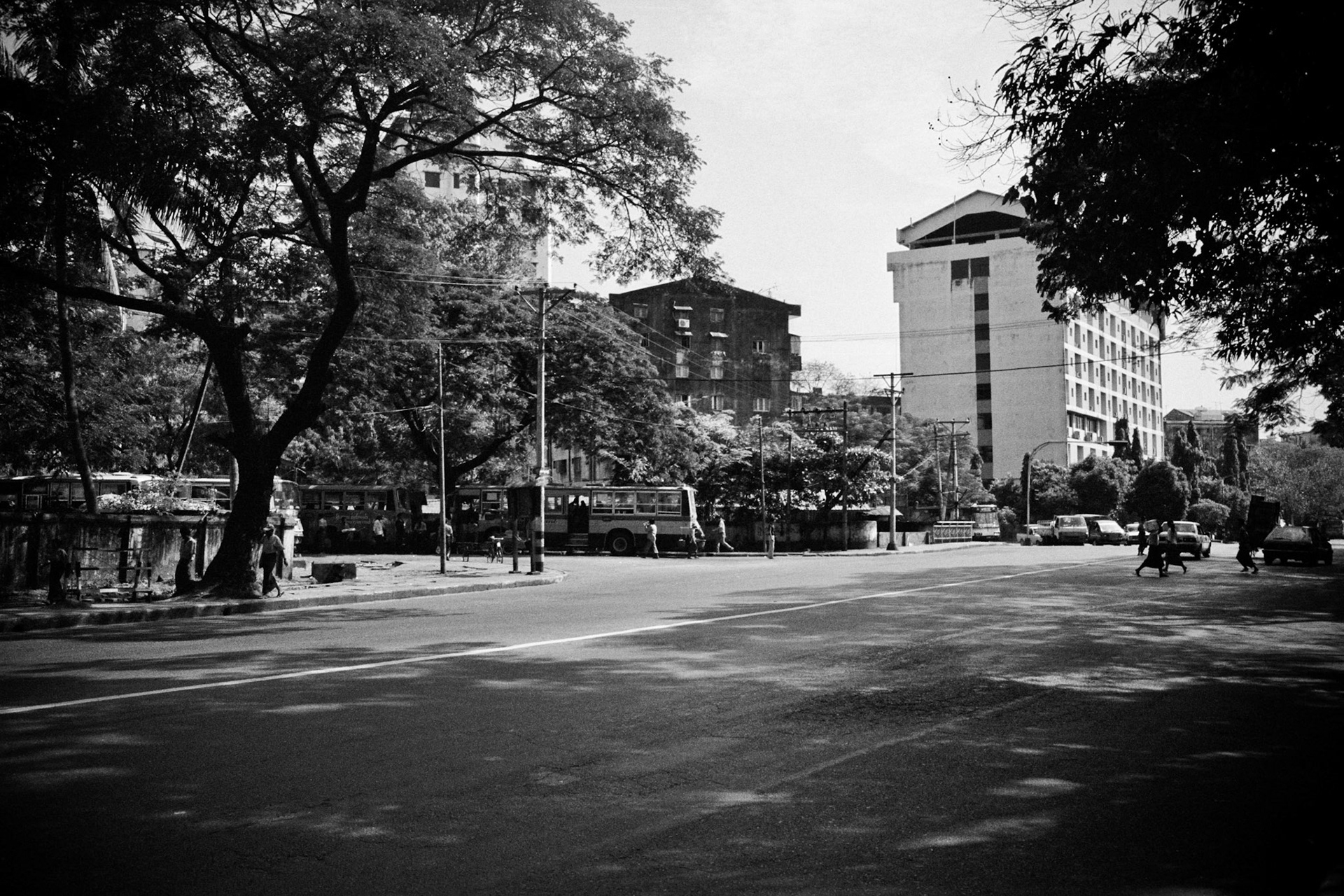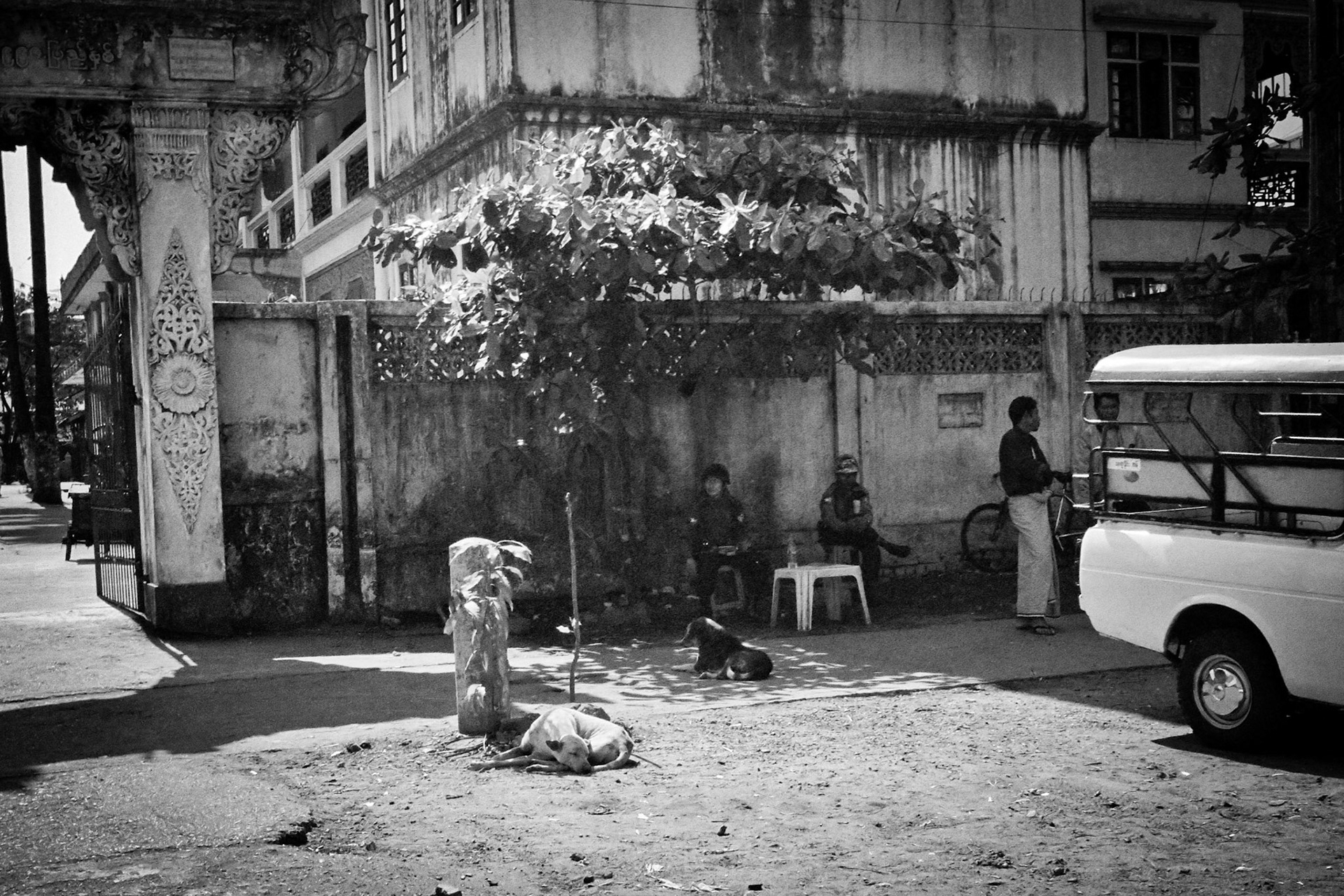
Ngwe Kyar Yan monastery in South Okkalapa township in Rangoon still lies empty just months after it was raided during the monk led Saffron Revolution

Lay Daungkan road in Tamwe township, where hundreds fled soldiers who opened fire on them. those who were found hiding in the nearby construction site of the National Library were shot dead in cold blood.

On 5th September 2007 Burmese soldiers attacked a peaceful protest by hundreds of monks. Several monks were captured and tied to the lamposts in this street and beaten. The following day the monkhood across Burma announced they would refuse alms from the military and the spark was set that would ignite the Saffron Revolution

Young monk from West monastery in Pakkoku, Myanmar (Burma) with scars to his neck where he was tied to a lampost and beaten by the military authorities during a peaceful protest. This incident became a catalyst for the mass demonstrations in September 2007 that became known as the Saffron Revolution.

Sule Pagoda road in downtown Rangoon was the centre point for the mass demonstrations as well as the place where the authorities launched their brutal crackdown. Japanese journalist Kenji Nagai was shot and killed at this junction with Anawrahta street.

Pansodan Bridge in Rangoon where students peacefully marched into the downtown area holding aloft the banned red 'fighting peacock' flags of the democracy movement. The authorities immediately opened fire killing three young men as they tried to flee.

Thakin Mya park in downtown Rangoon where soldiers opened fire on hundreds of people as they peacefully marched into the city centre.

Basic Education High School B.E.H.S. 3 in Tamwe township, Rangoon, was the scene of much bloodshed as Light Infantry Division 66 opened fire at the time that parents were collecting their children from school. A 16 year old boy was shot in the back and killed as he tried to climb over the wall to the school.

The junction of Thu Mingalar road and Thitsar road in South Okkalapa township. The authorities blockaded hundreds of protesters in this area before arresting them.

As children were leaving Basic Education High School B.E.H.S. 2 the soldiers threw smoke grenades and opened fire into the crowds gathered outside. Three people were shot dead inculding one child.

A sixteen year old boy carrying the buddhist Sasana flag was shot in the head and killed. He was taken to his home in Inwa street but the authorities arrived soon after and took his body away.

Many of the most serious incidents occured on Thitsar road in South Okkalapa township, Rangoon. Two young men were beaten to death by military thugs at this bridge as they fled from the oncoming soldiers.

Thitsar road in South Okkalapa where thousands of locals gathered after Ngwe Kyar Yan monastery was raided by the military authorities. The authorities opened fire killing many in order to disperse the crowds.

The brutality with which the authorities cracked down was plane to see at the junction of Waizayander road and Thitsar road where 2 people were beaten to death by soldiers.

Ngwe Kyar Yan monastery in South Okkalapa was raided in the middle of the night on 27th September 2007. Hundreds of monks were arrested and the monastery was ransacked by the Burmese authorities. The sign to the monastery was removed in an attempt by the regime to remind the public that all monasteries would be closed if they harboured any activists.

The gates to Ngwe Kyar Kan monastery were smashed open by an army truck in the middle of the night. Many monks managed to escape arrest by hiding in the neighbouring houses.

The military regime have thousands of militia thugs known as 'Swan Arr Shin' or 'Masters of Force' at their disposal to carry out attacks on people. Here members of Swan Arr Shin are stationed outside Ngwe Kyar Yan monastery keeping a close eye on anyone who comes near the now locked monastery.

The main entrance to Insein prison in Rangoon, Burma. The prison is notorious worldwide for its inhumane and dirty conditions, abusive techniques, and uses of mental and physical torture. It is used largely to repress political dissidents and one of it's most famous prisoners has been Aung San Suu Kyi who has been jailed there on 3 seperate occasions.

The old racecourse at Kyaik Ka San once again became a mass detention centre for the many thousands of people who were detained during the Saffron Revolution. Many were held here and tortured for weeks without their family knowing of their whereabouts.

Soldiers keep watch behind blockades on University Avenue, Rangoon, Burma. Since 1989 when Aung San Suu Kyi was first arrested, Burma's military regime have erected the rudimentary blockades to keep people away from her home.

Soldiers on patrol at a monasttic education centre in Thingyanyun township, Rangoon. Monasteries were taken over by the authorities in ther search for democracy activists.

Soldiers on watch outside a monastery near to Shwedagon Pagoda in Bahan township, Rangoon. Shwedagon Pagoda had been a focal point for monks to meet during the uprising.

Monasteries throughout Rangoon were raided with hundreds of monks rounded up and detained. The army then used the monasteries as there base and now some three months later many monasteries remain under the control of the military.

Burmese authorities are wary of all foreigners and journalists are banned from entering the country. even an innocent conversation with a local can result in their being detained for questioning.

A Burmese army officer talks to monks. In September 2007, thousands of protesters took to the streets of Rangoon to demonstrate against Burma's military regime. Three months later and the streets are quiet in a climate of fear.
























